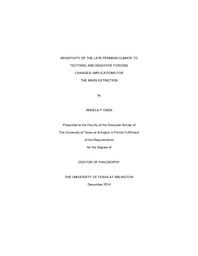
ATTENTION: The works hosted here are being migrated to a new repository that will consolidate resources, improve discoverability, and better show UTA's research impact on the global community. We will update authors as the migration progresses. Please see MavMatrix for more information.
Show simple item record
| dc.contributor.author | Osen, Angela | en_US |
| dc.date.accessioned | 2015-07-01T17:50:25Z | |
| dc.date.available | 2015-07-01T17:50:25Z | |
| dc.date.issued | 2014-12 | |
| dc.date.submitted | January 2014 | en_US |
| dc.identifier.other | DISS-12896 | en_US |
| dc.identifier.uri | http://hdl.handle.net/10106/24928 | |
| dc.description.abstract | The largest mass extinction occurred near the Permian-Triassic boundary (ca. 252 Ma). Significant carbon isotope shifts indicate that perturbations in the carbon cycle occurred during the Late Permian and persisted into the Early Triassic. The loss of biodiversity within the terrestrial and marine realms coincided with the eruption of the Siberian Flood Basalts and magma intrusion into coal beds, leading to the emission of greenhouse, sulfur, and other gases into the atmosphere. In this study, climate model output from the Community Climate System Model Version 3 with improved topographic features, along with a prediction of patterns of oceanic water masses and terrestrial biomes is compared with climate-sensitive sediments and phytogeographic reconstructions. Incorporating these features into the model will help to better understand the environmental changes that may have led to the mass extinction. The possible effects of a mid-ocean ridge and sills between the Paleo-Tethys and Panthalassa on water mass distribution and oxygen content have been investigated. Model results suggested that a mid-ocean ridge would not likely alter the global distribution of water masses; however, the introduction of sills could lead to enhanced stratification in the Paleo-Tethys. The response of climate-sensitive sediments and biomes to a carbon pulse of 4872 PgC into the atmosphere has been assessed to better understand the environmental changes that occurred during the Late Permian-Early Triassic transition. The analysis of climate simulations implied a poleward expansion of the Panthalassic temperate and tropical regions along with a transition of polar to temperate water masses. On the supercontinent of Pangea, an expansion of deserts within the inner continent is inferred. Extreme temperature increases coupled with changing precipitation patterns likely contributed to the mass extinction of much of the fauna and flora as suggested by the modeling results and phytogeographic patterns. | en_US |
| dc.description.sponsorship | Winguth, Arne M. E. | en_US |
| dc.language.iso | en | en_US |
| dc.publisher | Environmental & Earth Science | en_US |
| dc.title | Sensitivity Of The Late Permian Climate To Tectonic And Radiative Forcing Changes: Implications For The Mass Extinction | en_US |
| dc.type | Ph.D. | en_US |
| dc.contributor.committeeChair | Winguth, Arne M. E. | en_US |
| dc.degree.department | Environmental & Earth Science | en_US |
| dc.degree.discipline | Environmental & Earth Science | en_US |
| dc.degree.grantor | University of Texas at Arlington | en_US |
| dc.degree.level | doctoral | en_US |
| dc.degree.name | Ph.D. | en_US |
Files in this item
- Name:
- Osen_uta_2502D_12896.pdf
- Size:
- 16.62Mb
- Format:
- PDF
This item appears in the following Collection(s)
Show simple item record


